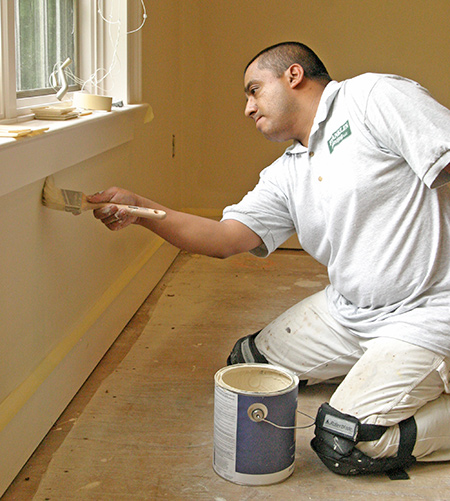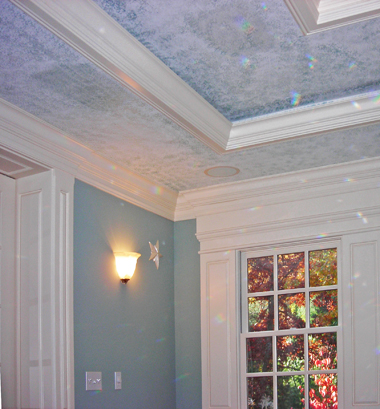Painting the interior of a historic home or building can feel like a weighty task. You want to preserve its charming authenticity while also breathing new life into it. It’s a good idea to ask, “Do I need to take a special approach to paint my historic home or business?”
If it is landmarked or listed on the National Register of Historic Places, the answer to your question is, Absolutely! There are restrictions on what surfaces you can paint, and there may even be restrictions on the colors that you can use. Check out the Secretary of the Interior’s Standards for Rehabilitation for national guidelines. Also, look into the local preservation ordinances where you live. You may need to get their approval on the paint color(s) that you choose. If your home or building is not landmarked, the answer to that question is more nuanced. You don’t have to follow any restrictions. It is still a good rule to only paint surfaces that have been painted before and use a historically accurate color.
How to Prep a Historic Home for Repainting
 Historic homes typically have many layers of paint on the walls, including layers of oil-based and acrylic or water-based paints. To remedy peeling paint and prevent it from happening in the future, it’s important to properly prep the surfaces.
Historic homes typically have many layers of paint on the walls, including layers of oil-based and acrylic or water-based paints. To remedy peeling paint and prevent it from happening in the future, it’s important to properly prep the surfaces.
Here’s a helpful checklist to follow:
Mist any surface you plan to scrap or sand with water before beginning. Since any home painted before 1978 may have a layer of lead paint, this is a necessary precaution to prevent you from inhaling lead dust.
If you are using a paint removal device, make sure the operating temperature is below 650° Fahrenheit or choose an infrared paint removal tool that doesn’t heat over 600.° This will prevent the risk of turning lead paint into a toxic vapor. Before applying a latex or acrylic paint over glossy oil paint, clean the surface and lightly sand it. Sand away paint that is greying.
If painting wood trim or another wood surface, use a moisture meter to determine the moisture content in the wood. If it’s over 15%, wait to paint it until it drops below that. If you paint wood that’s too wet, the paint won’t adhere.
Cover floors, furnishings, and any other surfaces that you do not plan to paint. Make sure that any tape you use during this process has a light adhesive. If you use tape with a strong adhesive, it could cause damage when it’s removed.
Safe Lead Paint Removal
According to the Environmental Protection Agency (EPA), you should anticipate that you will encounter lead paint in your home if it was built before 1978. If you plan to paint your home yourself, it’s a good idea to check out the EPA’s guide on repainting a home with lead paint. If you hire a contractor, ask them about the safety precautions they take when removing lead paint.
How to Choose the Right Paint
 The most critical decision, when deciding on paint for a historic home, is whether to choose an oil-based paint or acrylic paint. You should never paint oil-based paint over acrylic. You can paint acrylic paint over oil paint. The simplest way to find out what kind of paint is on your walls is to use a liquid paint splatter product on a small test area. If the paint splatter removal product can remove the color, it’s acrylic paint. If it doesn’t work, it’s oil paint. When you are ready to choose a paint, you may want to choose a color that’s close to the original or from a traditional paint palette.
The most critical decision, when deciding on paint for a historic home, is whether to choose an oil-based paint or acrylic paint. You should never paint oil-based paint over acrylic. You can paint acrylic paint over oil paint. The simplest way to find out what kind of paint is on your walls is to use a liquid paint splatter product on a small test area. If the paint splatter removal product can remove the color, it’s acrylic paint. If it doesn’t work, it’s oil paint. When you are ready to choose a paint, you may want to choose a color that’s close to the original or from a traditional paint palette.
Many paint manufacturers have a line of paints for historical homes, such as Benjamin Moore’s historical collection. If you have more questions about how to paint a historical home, reach out to the experts at Franklin Painting! We’ve been painting homes across central Connecticut for over 30 years!

Frank Campanelli, the esteemed founder of Franklin Painting LLC, has been leading the company since 1986. He takes immense pride in the stellar reputation his dedicated team has built by consistently delivering top-notch service to each customer.



